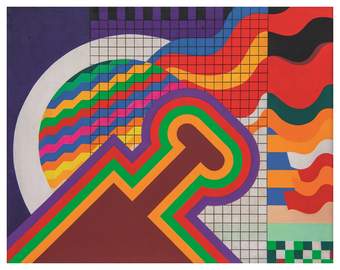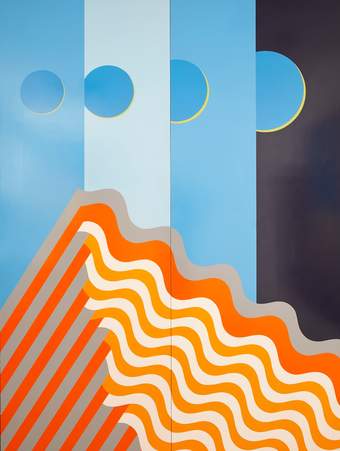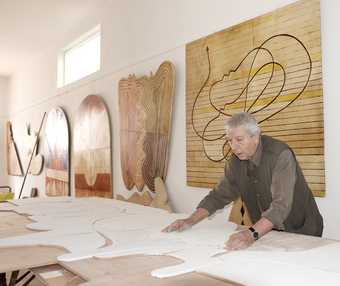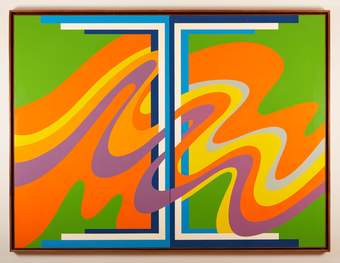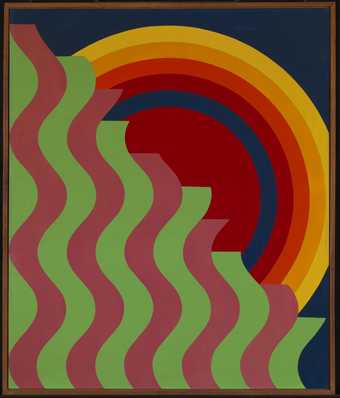The speakers in the video are Natalie Gayle (Presenter) and Anne Barlow (Director at Tate St Ives)
Natalie Gayle: Hello I'm at Tate St Ives where I'm going to be checking out the Casablanca Art School exhibition. From abstract painting to craft and ceramics, the exhibition celebrates the work of 22 artists from this new wave of Moroccan art. I'm about to go meet the curator to find out more.
Hi Anne, thank you so much for joining us. Could you just give us a little bit of background about the movement?
Anne Barlow: This exhibition brings together the work of 22 artists in a variety of media, from painting to sculpture to graphic design as well as textiles and tapestries. The Casablanca Art School was taken over in 1962 by a very young artist who was only 28 at the time Farid Belkahia. And he quite quickly brought on two other artists Mohamed Melehi and Mohammed Chabâa as well as the anthropologist Bert Flint and an art historian called Toni Mariani and they really changed the face of modernism in Casablanca from that time on. It was a radical break with the past and this was partly because Morocco itself had gained independence in 1956, so there's this feeling of wanting to kind of regain your own national identity. And so they effectively broke with tradition and instead they started to look at various aspects of modernism and they also started to look at artistic practices that were from their own region
Natalie Gayle: We’ll go and actually look at three of the major players now so should we head on over? So here we have Farid Belkahia.
Anne Barlow: Farid Belkahia is a really interesting artist because he starts out with kind of maybe more traditional approaches to painting because of the interest in applied arts and kind of metalwork and so on he starts to use copper and other materials in his painting, by which time he actually is using natural pigments and animal skin. Once the school began a lot of artists from outside Morocco became very interested in what was happening at the Casablanca Art School and also very influenced by it, ideas crossing from Europe, to Morocco America, to Morocco and so on.
Natalie Gayle: So this is Mohammed Chabâa.
Anne Barlow: So Mohammed Chabâa was one of the two main artists who Farid Belkahia invited to join him. They are known as the kind of core, the core trio of the Casablanca Art School. This is a beautiful example of a painting that he made in 1977 and you can see a lot of the kind of signature aspects of his work. He was very interested in graphic design and you can see strong kind of graphic elements in this particular piece. One of the most interesting aspects was actually that they really wanted to connect with the public environment. Chabâa famously said that the poster was a painting that was accessible to all. Many of these artists and others actually presented their work in public squares rather than in modern art museums, because actually at that time there were no modern art museums in which to show these works.
Natalie Gayle: Well should we head on over to the last person you picked out? This is probably one of my favourites from the exhibition. It's kind of one of the things I like in one painting. It's like sun, sea, sky, moon. I love it.
Anne Barlow: Yeah I mean, this is a totally stunning painting, it's called Volcanique and Mohamed Melehi made it in 1985. He was really known for this wave form that you can see and often there are multiple in any one painting. This period in particular is incredibly vibrant in terms of the use of colour.
Natalie Gayle: What would you just say was particularly special about this exhibition?
Anne Barlow: Well, we've seen the work of the three artists Melehi, Chabâa and Belkahia who are perhaps most well known. While these are all included in the exhibition, we have the work of students. We also have a lot of archival materials and we have the work of international artists who were very much inspired by the work that was happening at the Casablanca Art School.
Natalie Gayle: Well, thank you so much Anne, what an amazing group of people to learn about. Absolutely love this exhibition so thank you.
Anne Barlow: It’s a pleasure.
